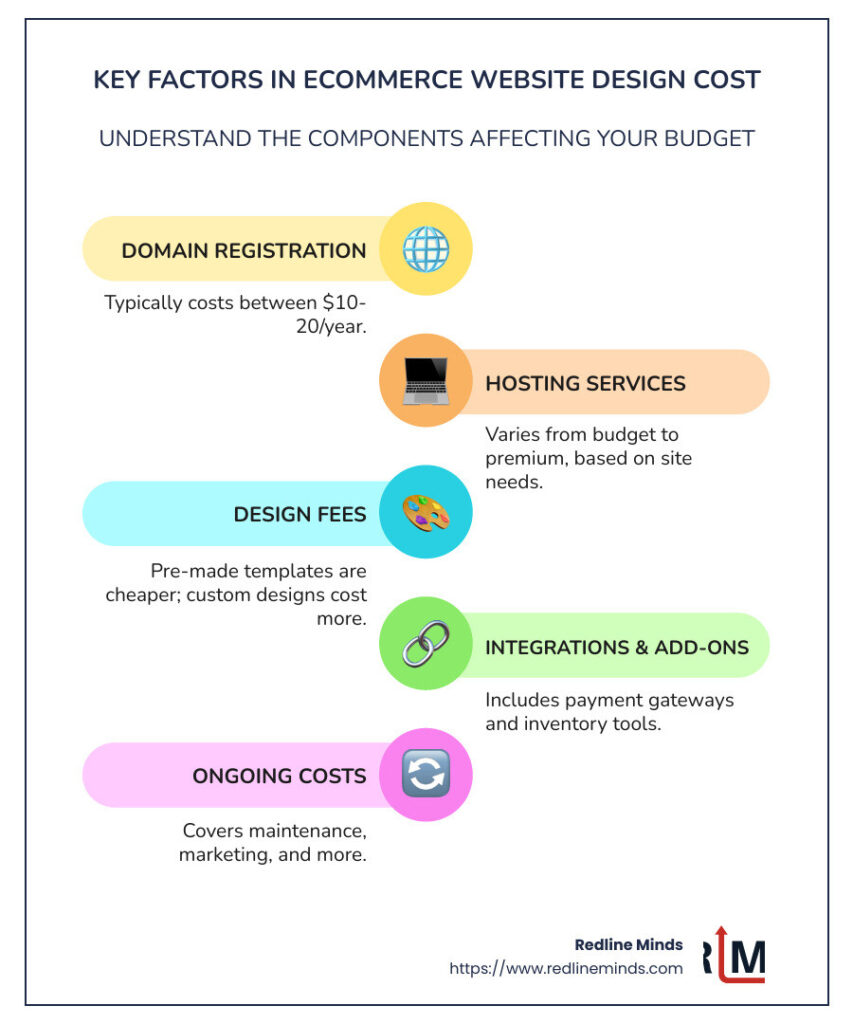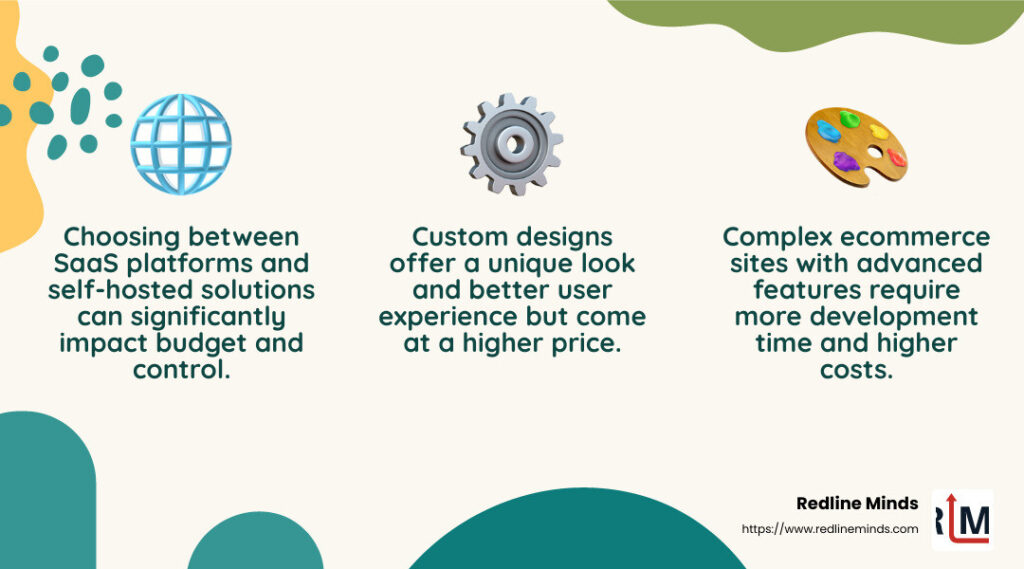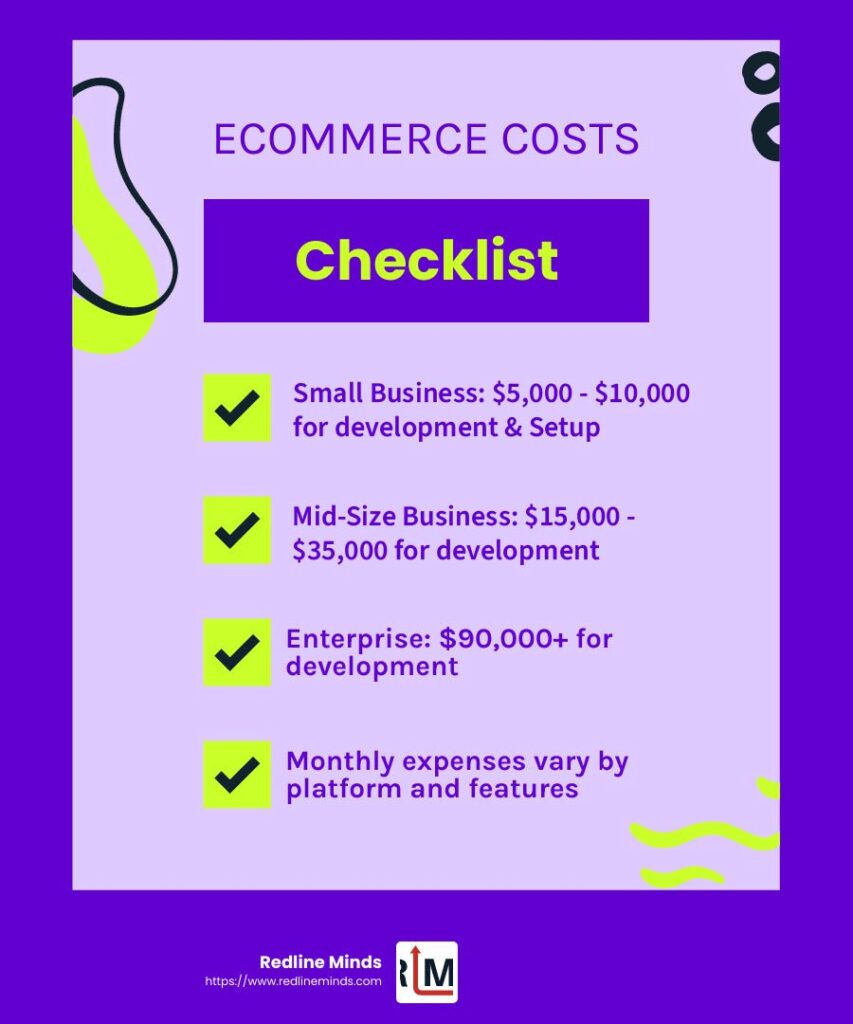Ecommerce Website Design Costs: What to Expect and How to Budget

eCommerce website design cost is a crucial factor for any online retailer evaluating their digital strategy. Understanding the price points can help businesses make informed decisions, especially when looking to improve online sales. Here’s a quick snapshot of what to expect:
- Domain registration: Starting as low as $10-20 per year.
- Hosting services: Can range from budget-friendly options to higher-end services, depending on site demands.
- Design fees: Pre-made templates are affordable, while custom designs and UX optimizations can add significantly to the pricing.
- Integrations and add-ons: From payment gateways to inventory management tools, each adds to the total cost.
- Ongoing costs: Ongoing expenses include maintenance, marketing, and customer service tools.
To set realistic expectations and understand these financial commitments, let’s dive deeper into each component.
My name is Lori Appleman, and I’ve spent nearly 25 years perfecting ecommerce strategies. From fast-growth startups to established businesses, I’ve seen the impact that an understanding of ecommerce website design cost has on growth and profitability.
Let’s explore how these costs stack up and what they mean for your business success.

Understanding Ecommerce Website Design Cost
When diving into the ecommerce website design cost, several elements come into play. Let’s break down the critical factors that influence these costs: platform choice, complexity, design specifications, and integrations.
Platform Choice
Your choice of platform is like picking the foundation for your online store. It sets the stage for everything else. Platforms like Wix offer built-in features that can save you time and money, while others might require numerous plugins to achieve the same functionality. The decision between a self-hosted or a SaaS platform can significantly affect your budget.
- SaaS platforms: Often come with a monthly fee but offer ease of use and support. SaaS carts tend to be more reliable and are great for those who don’t have developers on staff.
- Self-hosted platforms: Require more technical know-how but offer greater control and customization.
Complexity
The complexity of your ecommerce site is another major cost driver. A simple site with a few products will cost less than a robust site with thousands of SKUs and advanced features like real-time inventory updates.
- Simple sites: Lower upfront costs, ideal for small businesses or startups.
- Complex sites: Higher costs due to advanced features and greater development time.
Design Specifications
Design is not just about looks—it’s about function and user experience. A well-designed site can significantly impact conversion rates. You can choose between using a pre-made template or opting for a custom design:
- Template design: Cost-effective and quick to implement.
- Custom design: Offers a unique look and feel but comes with higher costs.

Integrations
Integrations allow your site to function smoothly with other tools and services. Whether it’s payment gateways, shipping solutions, or CRM systems, each integration adds to your overall cost.
- Payment Gateway Integrations: Essential for processing transactions but come with fees.
- Shipping Integrations: Automate shipping calculations and label printing, saving time.
- CRM and ERP Integrations: Streamline operations but require more investment.
- Marketing software: This type of software delivers emails and other types of campaigns that benefit from your store’s user data.
To sum up, understanding the ecommerce website design cost involves evaluating these key components. By carefully considering your platform choice, the complexity of your site, design needs, and necessary integrations, you can create a budget that aligns with your business goals.
Key Components Influencing Ecommerce Website Design Cost
When you’re planning an ecommerce website, understanding the ecommerce website design cost is crucial. This section breaks down key components that can influence these costs, helping you budget effectively.
Domain Registration
Your domain name is your website’s address. It’s a small but essential part of your ecommerce setup. On average, you can expect to spend USD 10-20 per year for a new domain. However, promotional offers can drop this to as low as USD 1 per year. If you plan to keep your domain for a long time, consider registering it for up to 10 years. This can cost between USD 50 – 150 and may help with SEO by establishing domain age.
Hosting
Hosting is where your website lives on the internet. Note that SaaS shopping carts such as BigCommerce, Wix, and Shopify handle all hosting as part of their plan. You do not need a hosting account in addition to a shopping cart account.
The cost can vary based on the hosting you choose:
- Shared Hosting: Budget-friendly, ideal for small sites.
- VPS Hosting: Offers more resources and flexibility.
- Dedicated Hosting: Best for large sites needing full control.
Each option has different costs and benefits, so choose based on your site’s needs and expected traffic.
SSL Certificates
An SSL certificate is vital for securing your site and building customer trust. It encrypts data, making transactions safe. Some hosting providers offer free SSL certificates, but premium options can cost USD 50 – 200 annually. This investment is crucial for protecting sensitive customer information.
Payment Gateways
To process online payments, you need a payment gateway. Popular options include PayPal, Stripe, and Square. Most charge transaction fees, typically around 2.9% plus $0.30 per transaction. Keep these fees in mind as they can add up over time, especially if your sales volume is high. If your business is doing at least 7 figures a year, you may be able to negotiate lower rates. Don’t be afraid to shop merchant bank accounts.
Plugins
Plugins add functionality to your site, like SEO tools, analytics, and marketing integrations. Costs for plugins can range from free to hundreds of dollars, depending on the complexity and features. For example, premium plugins might cost anywhere from $40 to $500. Choose plugins that align with your business needs to avoid unnecessary expenses.
Understanding these components helps you plan for your ecommerce website design cost effectively. Each element plays a role in the overall expense, so consider your specific needs and budget when making decisions.
Off-the-Shelf vs. Custom-Built Ecommerce Websites
When diving into ecommerce, one crucial decision is choosing between off-the-shelf solutions and custom-built sites. Each option has its own set of advantages and drawbacks, impacting your ecommerce website design cost and the control you have over your online store.
Off-the-Shelf Solutions
Off-the-shelf ecommerce platforms like Shopify or BigCommerce are popular choices for many businesses. They offer a quick and cost-effective way to launch an online store. With these platforms, you pay a subscription fee, which can range from $30 to several hundred dollars per month, depending on the plan and features you choose.
Key benefits of off-the-shelf solutions include:
- Ease of Use: These platforms are user-friendly, making it easy for anyone to set up a store without technical expertise.
- Features Included: They come with built-in tools for product management, payment processing, and basic SEO.
- Lower Initial Cost: Ideal for startups and small businesses with standard requirements.
However, there are some limitations:
- Transaction Fees: Some platforms charge additional fees unless you use their payment system.
- Customization Limits: While you can customize themes and add plugins, you might hit a wall if you need highly specialized features.
Custom-Built Sites
On the other hand, custom-built ecommerce websites provide maximum flexibility and control. This option allows for a completely personalized design and functionality, custom to your specific business needs.
Advantages of custom-built sites include:
- Unlimited Customization: You can create unique features and designs that align perfectly with your brand.
- Scalability: Custom sites can grow with your business, adapting to new needs and technologies.
But these benefits come with higher costs:
- Development Expenses: Hiring developers can cost anywhere from a few thousand to tens of thousands of dollars.
- Ongoing Maintenance: You’re responsible for updates and maintenance, which could require additional resources.
Making the Right Choice
The decision between off-the-shelf and custom-built solutions depends on your business size, budget, and long-term goals.
- Small businesses might prefer off-the-shelf platforms for their affordability and ease of use.
- Larger enterprises may opt for custom solutions to achieve specific functionality and branding.
Understanding your business needs and budget is key to determining the best path for your ecommerce website.
Ecommerce Website Design Cost Estimates
When planning for an ecommerce website, understanding the costs involved is crucial. The ecommerce website design cost can vary significantly depending on whether you’re a small business, a mid-size business, or an enterprise organization. Let’s break it down:
Small Business
For small businesses, keeping costs low while ensuring functionality is key. Typically, these businesses lean towards off-the-shelf solutions like Shopify, BigCommerce, or Squarespace. These platforms offer a range of plans, with basic subscriptions starting around $30 per month.
- Initial Setup: Expect to spend between $5000 to $10,000. This includes domain registration, hosting, and a basic website design.
- Ongoing Costs: Monthly fees for the platform and any additional plugins or features you might need.
Small businesses often benefit from the ease of use and quick setup that these platforms provide. They offer essential tools to manage products and process payments without needing a technical team.
Mid-Size Business
Mid-size businesses might require more customization and additional features to handle a larger volume of products and customers. This often means higher costs.
- Setup Costs: Ranging from $15,000 to $35,000, these expenses cover more advanced themes, custom design work, and integrations with third-party services.
- Monthly Expenses: These can include higher-tier subscription plans, which offer more features and scalability.
Mid-size businesses may choose to invest in custom plugins or hire developers to tailor their ecommerce site to better fit their growing needs.
Enterprise Organization
Enterprise organizations require robust, scalable solutions that can handle high traffic and complex operations. This often means opting for custom-built ecommerce sites.
- Development Costs: Can soar upwards of $90,000 or more, depending on the complexity of the features and integrations required.
- Maintenance and Upkeep: Enterprises need dedicated teams for ongoing maintenance, updates, and security, which adds to the cost.
- SaaS for Enterprise: Enterprise merchants are increasingly moving to SaaS carts or headless (a combination of SaaS and a custom frontend). These options, if they fit your needs, can reduce the total costs of ownership.
Finding the Right Fit
The ecommerce website design cost is heavily influenced by the size and needs of your business. Small businesses might find off-the-shelf solutions more cost-effective, while mid-size and enterprise organizations could benefit from the flexibility and scalability of custom-built sites.
Understanding these cost estimates helps you plan your budget effectively, ensuring that your ecommerce website supports your business goals without breaking the bank.
The Role of Design in Ecommerce Website Costs
Design plays a crucial role in shaping the ecommerce website design cost. Let’s explore how different design elements impact your budget.
Template Design
Using a pre-made template is often the most budget-friendly option. Platforms like Shopify and WooCommerce offer a variety of templates, some free and others priced between $30 to $300. These templates are a quick way to get your site up and running. They come with basic customization options, which can suit small businesses looking to save on costs.
However, while templates are economical, they might limit your ability to stand out. If your business needs a unique look, you might consider investing in custom design. They can also be bloated with a lot of unnecessary code that slows your site speed.
Custom Design
Custom design is a different ball game. It involves hiring a professional designer or agency to create a unique look for your website. Custom designs can range from $5,000 to $30,000 or more, depending on the complexity and features.
This option is ideal for businesses wanting to create a strong brand identity or needing specific functionalities not available in templates. It allows for greater flexibility and control over the design and user experience.
User Experience (UX)
User experience is a critical factor in ecommerce success. A well-designed UX can significantly boost conversion rates by making it easy for customers to navigate your site and complete purchases. This includes intuitive navigation, fast load times, and a smooth checkout process.
Investing in good UX design can add to your costs, but it often pays off. Improving UX might involve hiring a UX designer or using specialized tools, which can cost anywhere from $1,000 to $10,000.
Branding
Branding elements, such as a custom logo, consistent color schemes, and typography, contribute to the overall look and feel of your site. Consistent branding helps build trust and recognition among your customers.
While branding can be done in-house, many businesses choose to hire professionals to ensure a polished and cohesive look. Branding costs can vary widely, from $500 to $5,000 or more, depending on the level of detail and expertise required.
Design is not just about making your website look good; it’s about creating a seamless and memorable shopping experience for your customers. Balancing your design needs with your budget is key to building a successful ecommerce website.
Frequently Asked Questions about Ecommerce Website Design Cost
What is an ecommerce website?
An ecommerce website is your virtual storefront. Imagine a traditional store, but online. It allows businesses to sell products or services over the internet. Customers can browse, select, and purchase items from the comfort of their homes. This type of website is crucial in today’s digital age, offering convenience and expanding your reach to a global audience.
How much does an ecommerce website cost on average?
The cost of creating an ecommerce website can vary greatly. On average, if you’re working with a professional agency, expect to pay between $20,000 and $30,000. However, this is just an average and depends on several factors. These include the platform you choose, the number of products, and the complexity of your design and features. For smaller budgets, using platforms like Shopify or BigCommerce with pre-made templates can start as low as a few hundred dollars. In contrast, custom-built sites with advanced features can reach tens of thousands of dollars.
How can you calculate the cost of an ecommerce website project?
Calculating the cost of an ecommerce website project involves understanding your specific business needs. While some companies offer online cost calculators, they can only give a rough estimate. Important factors include:
- Platform Choice: Whether you choose Shopify, BigCommerce, or a custom solution affects your budget.
- Number of Products: More products can mean more complex data management and integration needs.
- Design Requirements: Custom designs cost more than using a template.
- Data Integrations: Needing integrations with ERP systems, payment gateways, or other software can increase costs.
For a more accurate estimate, it’s best to consult with professionals who can tailor a quote to your specific requirements. This ensures you understand all potential expenses and can budget effectively for your ecommerce website.
Conclusion
Building a successful ecommerce website is a journey that involves many decisions. From choosing the right platform to understanding the various costs involved, each step is crucial. At Redline Minds, we specialize in guiding businesses through this complex process. Our focus is on ecommerce consulting, web development, and online marketing, ensuring that your online store not only meets your needs but also scales with your growth.
Strategy development is at the heart of what we do. We work closely with you to understand your business goals and craft a custom plan that maximizes your online potential. Whether you’re starting from scratch or looking to improve an existing site, our team is here to help every step of the way.
Partnering with us means tapping into a wealth of expertise in UX/UI design, SEO, and ecommerce technology. We believe that a well-designed and strategically planned ecommerce website is an investment in your business’s future. By focusing on user experience and strategic growth, we help you create a platform that not only attracts visitors but converts them into loyal customers.
If you’re ready to take your ecommerce business to the next level, explore our ecommerce website design services and see how we can help you achieve your goals. Let’s build something great together!
